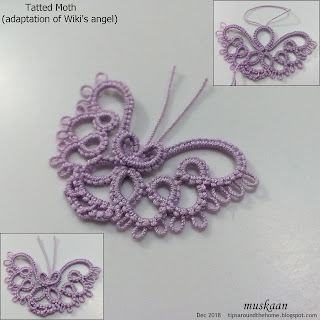along with hearts and angels!
You know how I enjoy extracting motifs and smaller designs from a larger pattern and highlighting them through colour. Don’t
get me wrong – I love all-white snowflakes (such as this one), but the need to play around gets
the better of me ;-P Perhaps I use colours as a Freudian cover-up to hide my
tatting flaws ?! Also, the stiffness of some of the white threads is
off-putting.
Sharon Briggs has been on a snowflake-designing spree for the past several weeks. And
I jumped in with a few flowery expressions – flower flakes! These were made a
few weeks back during my convalescence, with scarcely any notes. I don’t even remember my tatting
order. A couple of them cupped a bit, but in the end they blocked out fine. Some
of these could look good tessellated, hence I have included dimensions for both
point-to-point and the length as a tiled motif.
TIP : All
her snowflakes can be worked continuously. Due to use of colours, I worked some
of the rounds separately, while in some one thread continued for some rounds.
Working in one pass is optional – for those not comfortable with split rings
and split chains, cut and tie after a round and start next round afresh.
Techniques I used : 2-shuttle, one-pass,
ctm, rosette/rose medallion, daisy medallion, lock join, thrown/floating rings,
dimpled rings, split ring &/or split chain to climb out/climb in, 3 threads (double shuttle).
TõT
Flower Flakes –
stylised
1. Poinsettia
Anchor size 40 : 6½ cms as flake ; 5½ cms as motif
She called it "unimaginative". Hardly ! I could see a
poinsettia there, though my model seems to be squatter than her's. I wouldn’t
mind adding one more round to bring in a more petal-y poinsettia look.
2. Blue Bonnet (top view)
Anchor size 40 : >4 cms as flake ; <4 cms as motif
I came across blue bonnets in a story I was reading and loved them.... which is how I had visualized this in shades of blue. I wanted to make the outer round
in a darker shade, except I'd have to use embroidery threads & didn't want to hamper my tatting flow.
3. Cattleya Orchid
Anchor
white & Lizbeth purple splendour size 40 - 4½ cms as flake ; 4 cms as motif
I like how this turned out !!!
4. Madonna Lily
Anchor size 40 : 7 cms as flake ; >6 cms as motif
I
simply love the ‘filigree’ and colours would probably take away from that
look. Hence, a white lily ; the central ring could’ve been yellow, though.
I'm hoping to give this another go in colours though - it's such a pretty pattern!
I'm hoping to give this another go in colours though - it's such a pretty pattern!
I’m
pretty certain I mixed up 2 whites while making it – one was a tad finer,
vintage.
TõT
Hearts and Angels
I
test-tatted this Daisy Ring Heart pattern.
Anchor size 40 : 7½ cms as flake ; <7 cms as motif
Despite
using very small picots in the penultimate round,
the outermost round required
7 ds chain segments throughout – just as Sharon
But
do you see the angels between the hearts?!
Or perhaps bats if you want to mix in Halloween ;-P
Or perhaps bats if you want to mix in Halloween ;-P
Y
Ever
since her first heart snowflake, I wanted to make only the heart in red. I’ll
get to that, but for this December 22, 2018 pattern I used pink hearts against
a cream thread.
Anchor size 40 : 8 cms as flake ; 7 cms as motif
I
started with one shuttle and ball, ctm for the central ring.
Then
I included a pink shuttle for the hearts. Since I couldn’t work the connecting
chains with direct tatting (unflipped or reverse stitch), they were tatted with
double shuttles – the 2 shuttles stuck together temporarily.
The
2 outer rounds were worked with single shuttle and ball again.
Y
The above pic was taken before I worked the pink hearts flake.
I now have 8 of her 2018 flakes tatted (2 more flower flakes here).
There
are still a few more of her flakes I’d like to tat in the coming days.
Except
she’s belting them out faster than I can tat ;-P What a bonanza for tatters !!!
TõT
Related Posts
Thank you, Sharon









































